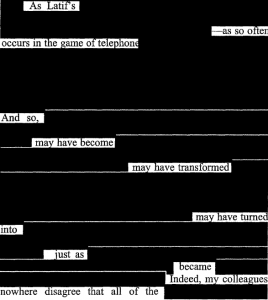A Primer On Why Schuelke Report Of DOJ Misconduct Is Important
 Yesterday morning, the District of Columbia Court of Appeals entered its per curiam order denying a DOJ prosecutor’s motion for stay of the release of the Schuelke Report on prosecutorial misconduct in the Ted Stevens criminal case. As a result, barring unforeseen Supreme Court intervention, later this morning the full 500 page plus Schuelke Report will be released by Judge Emmet Sullivan of the DC District Court. What follows is a recap of the events leading up to this momentous occasion, as well as an explanation of why it is so important.
Yesterday morning, the District of Columbia Court of Appeals entered its per curiam order denying a DOJ prosecutor’s motion for stay of the release of the Schuelke Report on prosecutorial misconduct in the Ted Stevens criminal case. As a result, barring unforeseen Supreme Court intervention, later this morning the full 500 page plus Schuelke Report will be released by Judge Emmet Sullivan of the DC District Court. What follows is a recap of the events leading up to this momentous occasion, as well as an explanation of why it is so important.
The existence of rampant prosecutorial misconduct in the Department of Justice case against Alaska Senator Ted Stevens was crystal clear before the jury convicted him in late October 2008 on seven counts of false statements in relation to an ethics investigation of gifts he received while in office. The trial judge, Emmet Sullivan of the District of Columbia District Court, could well have dismissed the case before it ever went to the jury for verdict but, as federal courts of all varieties are wont to do, he gave the DOJ the benefit of the doubt. It, as is all too often the case these days, proved to be a bridge too far for the ethically challenged DOJ.
Within a week of the ill be gotten verdict obtained by the DOJ in the criminal case, Ted Stevens had lost his reelection bid, after serving in the Senate for 40 years (the longest term in history). Before Stevens was sentenced, an FBI agent by the name of Chad Joy filed a whistleblower affidavit alleging even deeper and additional prosecutorial misconduct, and, based on the totality of the misconduct, Judge Emmet Sullivan, on April 7, 2009, upon request by newly sworn in Attorney General Eric Holder, dismissed with prejudice all charges and convictions against Ted Stevens.
But Emmet Sullivan did not stop with mere dismissal, he set out to leave a mark for the outrageous unethical conduct that had stained his courtroom and the prosecution of a sitting United States Senator:
Judge Emmet G. Sullivan, speaking in a slow and deliberate manner that failed to conceal his anger, said that in 25 years on the bench, he had “never seen mishandling and misconduct like what I have seen” by the Justice Department prosecutors who tried the Stevens case.
Judge Sullivan’s lacerating 14-minute speech, focusing on disclosures that prosecutors had improperly withheld evidence in the case, virtually guaranteed reverberations beyond the morning’s dismissal of the verdict that helped end Mr. Stevens’s Senate career.
The judge, who was named to the Federal District Court here by President Bill Clinton, delivered a broad warning about what he said was a “troubling tendency” he had observed among prosecutors to stretch the boundaries of ethics restrictions and conceal evidence to win cases. He named Henry F. Schuelke 3rd, a prominent Washington lawyer, to investigate six career Justice Department prosecutors, including the chief and deputy chief of the Public Integrity Section, an elite unit charged with dealing with official corruption, to see if they should face criminal charges.
On August 9, 2010, Ted Stevens died in a small plane crash in Alaska, never having seen the results of Henry Schuelke’s special prosecutor investigation into the misconduct during the Stevens criminal case. And lo, all these years later, we finally sit on the cusp of seeing the full Schuelke report in all its gory glory.
On November 21, 2011, Judge Sullivan issued a scathing order in relation to his receipt of Henry Schuelke’s full report, and how it would be reviewed and scheduled for release to the public. Actually, scathing is a bit of an understatement. The order makes clear not only is Schuelke’s report far beyond damning, but Judge Sullivan’s level of anger at the misconduct of the DOJ has Read more →


